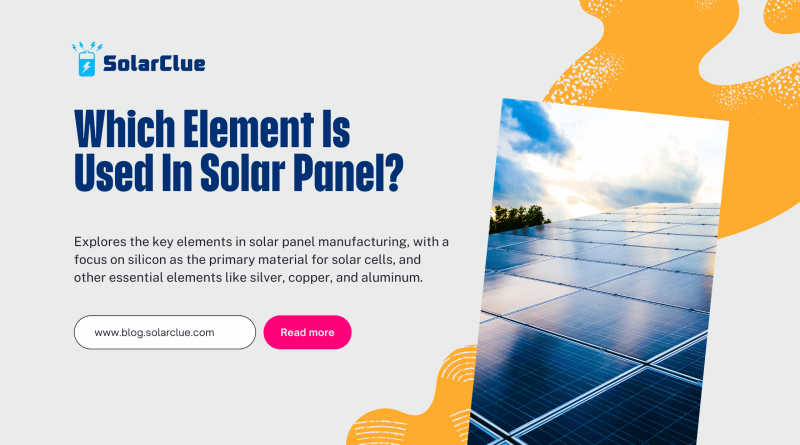Which Element Is Used In Solar Panel?
Solar panels are a cornerstone of renewable energy, and their efficiency, durability, and cost are largely determined by the materials used in their construction. This blog post explores the key elements in solar panel manufacturing, with a focus on silicon as the primary material for solar cells, and other essential elements like silver, copper, and aluminum.
Table of Contents
Silicon as the Foundation of Solar Panels
Silicon is the most critical material in solar panel manufacturing. It serves as the primary semiconductor in photovoltaic (PV) cells due to its excellent electrical properties and abundance. Silicon solar cells are created through a process that involves purifying raw silicon, forming it into wafers, and doping it with other elements to create a positive-negative (p-n) junction. This junction is crucial for generating electric current when the cell is exposed to sunlight.
The Role of Silver, Copper, and Aluminum in Solar Panel Construction
Silver: Silver is used in the form of conductive paste applied to the front and rear contacts of the solar cells. Its high conductivity ensures efficient electron flow, which is essential for the overall performance of the solar panel.
Copper: Copper is used primarily in the wiring and electrical connections within the solar panel. Its excellent electrical conductivity and flexibility make it ideal for carrying current from the solar cells to the external circuit.
Aluminum: Aluminum is often used in the frame of the solar panel due to its lightweight, strength, and resistance to corrosion. It also serves as a back-surface field (BSF) layer in some solar cells, which helps improve efficiency by reflecting light back into the cell.
Other Materials Used in Solar Panel Manufacturing
Encapsulants: Materials like ethylene-vinyl acetate (EVA) are used to encapsulate the solar cells, protecting them from moisture and mechanical damage.
Glass: The front surface of most solar panels is covered with tempered glass, which provides durability and allows sunlight to pass through with minimal reflection.
Backsheet: The backsheet is a layer of protective material, typically made of polymers, which insulates and protects the solar panel from environmental factors.
Anti-Reflective Coatings: These coatings are applied to the surface of the solar cells to reduce the reflection of sunlight, thereby increasing the amount of light absorbed and improving efficiency.
The Impact of Material Purity and Quality on Solar Panel Performance
The purity and quality of materials used in solar panels significantly impact their performance. High-purity silicon reduces electron recombination, which enhances the efficiency of the solar cells. Similarly, the quality of silver, copper, and aluminum affects the electrical conductivity and durability of the panels. Using high-quality encapsulants, glass, and backsheets ensures long-term performance and reliability.
Key Materials in Solar Panel Manufacturing
| Material | Function | Impact on Performance |
|---|---|---|
| Silicon | Primary semiconductor in PV cells | High efficiency, abundant, durable |
| Silver | Conductive paste for cell contacts | Excellent conductivity, critical for efficiency |
| Copper | Wiring and electrical connections | High conductivity, flexible, durable |
| Aluminum | Frame and back-surface field (BSF) layer | Lightweight, strong, corrosion-resistant |
| Encapsulants | Protection for solar cells | Protects from moisture and damage |
| Glass | Front cover of the panel | Durability, allows light transmission |
| Backsheet | Insulates and protects the panel | Environmental protection, electrical insulation |
| Anti-Reflective Coatings | Reduces sunlight reflection, increases absorption | Improves efficiency |
The Search for Alternative Materials to Reduce Costs and Increase Efficiency
Researchers are continuously exploring alternative materials to reduce the costs and increase the efficiency of solar panels. Perovskite solar cells, for instance, have shown promise due to their high efficiency and lower production costs compared to silicon cells. Additionally, organic photovoltaics (OPVs) and thin-film solar cells are being developed to offer flexible and lightweight alternatives.
The Recycling of Materials from Old Solar Panels
Recycling materials from old solar panels is becoming increasingly important as the number of installations grows. Silicon, glass, aluminum, and other components can be recovered and reused, reducing the environmental impact and conserving resources. Effective recycling processes help manage waste and promote sustainability in the solar industry.
The Future of Materials Used in Solar Panel Production
The future of solar panel manufacturing lies in the development of new materials and technologies that enhance efficiency and reduce costs. Innovations in nanotechnology, advanced coatings, and composite materials hold the potential to revolutionize solar energy production. As research continues, the solar industry aims to create panels that are not only more efficient but also more environmentally friendly and economically viable.
Conclusion
Here at SolarClue®, we offer a smart, practical, and “beautiful” solution. You will be answered for all the questions related to Solar.
We provide all kinds of brands that are the Best Solar panels in India.
If you are the one who is planning for the solar power system. Don’t hesitate to contact our team!
Looking forward to empowering you with solar energy, just like hundreds of our other clients!




